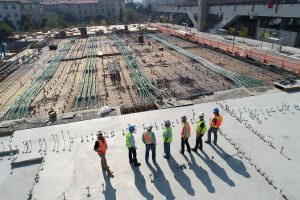The export of defense equipment to Saudi Arabia involves significant financial transactions, and non-payment can pose a serious challenge to exporters. To navigate this issue effectively, it’s crucial to understand the structured recovery system designed to manage unpaid defense exports. This article will delve into the three-phase recovery system, exploring the steps taken from initial contact to potential litigation, and the financial considerations involved in the collection process.
Key Takeaways
- A three-phase recovery system is implemented to manage non-payment in defense equipment exports, with escalating actions from communication attempts to legal proceedings.
- Within the first 24 hours of non-payment, initial recovery efforts include sending demand letters and conducting investigations to gather debtor information.
- Persistent communication strategies and skip-tracing are employed in early collection efforts, transitioning to legal intervention if these fail.
- Legal pressure in Phase Two involves drafting demand letters on law firm letterhead and persistent contact by attorneys, evaluating the case for litigation if necessary.
- Financial considerations include competitive collection rates based on claim age and volume, with additional costs incurred for accounts requiring legal action.
Understanding the Recovery System for Unpaid Defense Exports
Overview of the Three-Phase Recovery System
We stand at the forefront, equipped with a robust three-phase Recovery System designed to navigate the complexities of unpaid defense exports. Our mission is clear: recover funds efficiently and effectively.
In Phase One, we spring into action within 24 hours. Our approach is multi-faceted:
- Sending the first of four letters via US Mail
- Conducting skip-tracing and investigations
- Engaging in persistent communication attempts
Should these efforts not yield results, we escalate to Phase Two, where legal muscle comes into play. Here, our affiliated attorneys within the debtor’s jurisdiction take the reins, drafting demand letters and maintaining persistent contact.
In the event of persistent non-payment, Phase Three is our final stand. We assess the viability of asset recovery and, if warranted, proceed with litigation. Our commitment is to your financial recovery, with no payment obligation should litigation fail.
Our rates for recovery services are competitive and vary based on the age and volume of claims. It’s a strategic process, where managing non-payment and enforcing payment terms are critical to success.
Initial Actions Taken Within 24 Hours
Time is of the essence when dealing with non-payment. Within the first 24 hours, we spring into action. Our first step is dispatching a series of letters to the debtor, ensuring they’re aware of the urgency. Simultaneously, we conduct thorough skip-tracing and investigations to secure the most accurate financial and contact details.
Our collectors are relentless, employing a mix of phone calls, emails, text messages, and faxes to reach a resolution. We’re committed to making daily attempts, pushing for a swift settlement.
If these efforts don’t yield results, we’re prepared to escalate. The transition to Phase Two is seamless, with our affiliated attorneys ready to apply legal pressure. Our goal is clear: recover your funds efficiently and effectively.
Daily Attempts and Escalation to Phase Two
We’re relentless in our pursuit. Daily attempts to reach a resolution are our standard protocol. Persistence is key; we exhaust every communication channel – calls, emails, texts, faxes. When these efforts don’t yield results within 30 to 60 days, we escalate to Phase Two.
In Phase Two, we leverage the authority of our legal network. A local attorney within the debtor’s jurisdiction takes the helm, drafting demand letters and making persistent contact attempts. It’s a seamless transition, ensuring no momentum is lost.
Here’s a snapshot of our escalation process:
- Initial daily contact attempts using various communication methods.
- Evaluation of debtor’s response and willingness to resolve the debt.
- Escalation to Phase Two with attorney involvement if resolution is not reached.
Phase One: Early Stage Collection Efforts
The Role of Skip-Tracing and Investigations
We jump into action with skip-tracing and investigations, digging deep to uncover the best financial and contact information. Our goal: to pinpoint debtor whereabouts and assets—a critical first step in the recovery process.
Skip-tracing is not just about finding people; it’s about piecing together a financial puzzle. We leverage every tool at our disposal: phone calls, emails, text messages, faxes, and more. Persistence is key, and our daily attempts during the initial 30 to 60 days are relentless.
If our efforts in Phase One don’t yield results, we don’t hesitate. We escalate to Phase Two, involving our network of attorneys to apply legal pressure.
Our approach is structured, yet flexible, adapting to the unique challenges of each case. We’re committed to addressing non-payment issues, ensuring financial stability, and successful debt recovery.
Communication Strategies to Engage Debtors
In our quest to recover unpaid defense exports, we deploy a debt recovery strategy that’s both persistent and persuasive. We initiate contact within the first 24 hours, setting the tone for a proactive approach. Our daily contact attempts are not just about persistence; they’re about opening a dialogue and understanding the debtor’s position.
Tailored communication is key. We adapt our strategy to each unique situation, whether it’s through phone calls, emails, or even text messages. It’s not just about the frequency of contact, but the quality of the interaction. We aim to negotiate terms that are acceptable to both parties, always with the backdrop of our legal expertise to guide the process.
Our goal is to manage late payments effectively, ensuring that every step we take is calculated and aimed at resolution.
Here’s a quick rundown of our communication tactics:
- Establish immediate contact to assert presence
- Use varied communication channels for outreach
- Engage in active listening to understand debtor circumstances
- Negotiate with the intent to find a mutually beneficial solution
- Escalate to legal intervention only when necessary
Transitioning to Legal Intervention if Necessary
When our persistent collection efforts hit a wall, we pivot to a more assertive stance. Legal intervention becomes our next course of action. We’ve exhausted the friendly reminders and the firm demands; it’s time to bring in the legal muscle.
We don’t take this step lightly. It’s a calculated move, signaling to the debtor the seriousness of their non-payment.
Our affiliated attorneys step in, brandishing the power of the law. They’re our front line in this escalated phase, equipped to draft demand letters that carry the weight of legal consequences. Here’s what you can expect:
- Immediate drafting of demand letters on law firm letterhead.
- Persistent contact attempts by the attorney’s office.
- A thorough evaluation of the case for further action.
Should we proceed to litigation, be prepared for upfront costs. These typically range from $600 to $700, depending on the debtor’s jurisdiction. It’s a tough decision, but one that could lead to full recovery of your funds.
Phase Two: Legal Pressure and Local Attorney Involvement
Drafting Demand Letters on Law Firm Letterhead
We escalate our recovery efforts by leveraging the authority of legal representation. Demand letters drafted on law firm letterhead signify a serious escalation in our collection attempts. This step often prompts immediate action from debtors, aware of the potential legal ramifications.
Persistence is key. Our affiliated attorneys ensure that the debtor’s attention is captured through a series of letters, coupled with relentless follow-up calls. The impact of receiving official correspondence from a law firm cannot be understated—it’s a clear signal that we are prepared to take further action if necessary.
The transition to legal pressure is a calculated move. It’s designed to convey the gravity of the situation to the debtor, while still leaving room for negotiation and resolution.
Should these efforts not yield the desired results, we are ready to evaluate the case for more decisive legal action. Our approach is methodical, ensuring that every step taken is strategic and effective in recovering what is owed.
Persistent Contact Attempts by the Attorney’s Office
Once the baton is passed to our legal team, the pressure intensifies. Persistent contact is key. Our attorney’s office doesn’t let up; they’re on the phone, drafting emails, and sending letters relentlessly. Every angle is worked to reach a resolution.
Persistence pays off, but it’s not just about frequency—it’s about strategy. We tailor our approach to each debtor’s situation, ensuring our communication is as effective as it is constant.
We’re not just chasing payments; we’re seeking a fair and swift resolution for all parties involved.
Here’s a snapshot of our typical contact schedule:
- Day 1: Demand letter sent on law firm letterhead
- Day 3: Follow-up phone call
- Day 7: Email reminder of legal implications
- Day 10: Second follow-up call
- Weekly thereafter: Ongoing communication until resolution
This structured approach maximizes the chances of recovery before escalating further.
Evaluating the Case for Further Action
We’ve reached a critical juncture. Our next move could define the outcome. It’s time to weigh the facts and decide: do we close the case, or do we litigate?
Assessment is key. We scrutinize the debtor’s assets, the strength of our claim, and the likelihood of recovery. If the odds are against us, we recommend closure—no further costs to you. But if there’s a chance, we prepare for battle.
Here’s the decision fork:
- Option 1: Close the case. You owe us nothing.
- Option 2: Litigate. Upfront costs apply, but we fight for every penny owed—including legal fees.
Our expertise guides you, but the final call is yours. We’re in this together, strategizing for success or minimizing losses.
Phase Three: Deciding on Litigation and Understanding Costs
Assessing the Viability of Asset Recovery
We weigh every angle before recommending litigation. Asset recovery is not a gamble; it’s a calculated decision. We meticulously investigate the debtor’s assets and the surrounding facts of the case. If the likelihood of recovery is slim, we advise case closure, sparing you unnecessary costs.
Viability is key. We consider the debtor’s financial standing and the enforceability of the claim. Should the prospects look favorable, we present you with the option to litigate. The choice is yours—withdraw the claim at no cost or proceed with legal action.
We’re transparent about the financials. Upfront legal costs range from $600 to $700, depending on jurisdiction. These cover court costs, filing fees, and the initiation of the lawsuit. No recovery, no fees—it’s that simple.
The Decision to Litigate and Associated Costs
When we reach Phase Three, the crossroads of litigation looms. We must weigh the potential for recovery against the upfront costs. These costs are not trivial; they include court fees, filing charges, and other legal expenses, typically ranging from $600 to $700. The decision is stark: proceed and pay, or withdraw and owe nothing.
- If we choose to litigate, we commit to the financial investment with the hope of full recovery.
- Should we withdraw, we can continue standard collection efforts or close the case entirely.
The choice is ours, but it’s not made lightly. Every dollar spent on litigation is a gamble on success.
Remember, if litigation does not result in payment, our obligation to pay the firm or attorney ends. We close the case, absorbing the costs, but with no further financial liability.
Consequences of Unsuccessful Litigation
When we decide to litigate, we’re aware of the risks. If our legal efforts don’t yield results, the case closes, and we absorb the costs. We’ve seen legal costs for Phase Three range from $600 to $700, covering court fees. But, in the event of unsuccessful litigation, no fees are owed.
Our experience in USA-Saudi projects emphasizes the need for clear communication and a tailored approach. This is crucial to avoid the pitfalls of litigation.
We must always weigh the potential gains against the possibility of an unsuccessful outcome.
Remember, the decision to litigate is never taken lightly. It’s a calculated risk, with the potential for significant impact on our financials and business relationships.
Financial Considerations and Collection Rates
Competitive Collection Rates Explained
We understand the importance of competitive collection rates in the recovery of unpaid defense exports. Our rates are designed to be fair and incentivize swift recovery actions. The younger the debt, the lower the fee—a principle that encourages early intervention and maximizes return.
Here’s a quick breakdown of our rates based on claim age and volume:
-
For 1-9 claims:
- Under 1 year: 30%
- Over 1 year: 40%
- Under $1000: 50%
- With attorney: 50%
-
For 10+ claims:
- Under 1 year: 27%
- Over 1 year: 35%
- Under $1000: 40%
- With attorney: 50%
Our tiered pricing structure ensures that the more you commit, the more you save. It’s our way of saying thank you for trusting us with your recovery needs.
Remember, these rates are part of a strategic approach to debt recovery. They reflect our commitment to providing value while maintaining the highest standards of service.
Rate Variations Based on Claim Age and Volume
We understand that collection rates fluctuate based on the age of the claim and the volume of accounts. Here’s how we break it down:
- For 1-9 claims, rates are higher for older accounts and smaller amounts.
- For 10 or more claims, we offer reduced rates, rewarding your bulk submissions.
Our structured rate system ensures fairness and incentivizes timely action. Consider the following table for a quick reference:
| Claims Submitted | Accounts < 1 Year | Accounts > 1 Year | Accounts < $1000 | Attorney Placed Accounts |
|---|---|---|---|---|
| 1-9 | 30% | 40% | 50% | 50% |
| 10+ | 27% | 35% | 40% | 50% |
Remember, the sooner you act, the better your rate. Procrastination can be costly, not just in potential recovery but also in the rates you pay.
Cost Implications of Accounts Requiring Legal Action
When we decide to escalate to legal action, we’re faced with a stark choice. We either commit to the upfront costs or step back, potentially leaving debts uncollected. The initial legal fees, including court costs and filing fees, typically range from $600 to $700, based on the debtor’s jurisdiction. These are necessary to initiate a lawsuit and pursue the owed funds aggressively.
Our structured recovery system ensures that if litigation does not result in recovery, you owe us nothing further. It’s a no-win, no-fee assurance that aligns our interests with yours. However, it’s crucial to understand that accounts placed with an attorney incur a 50% collection rate, reflecting the increased effort and resources deployed.
We weigh the costs against the likelihood of recovery, making a calculated decision on whether to proceed with litigation.
Here’s a quick breakdown of our collection rates for accounts requiring legal action:
- Accounts under 1 year in age: 30% of the amount collected.
- Accounts over 1 year in age: 40% of the amount collected.
- Accounts under $1000.00: 50% of the amount collected.
- Accounts placed with an attorney: 50% of the amount collected.
These rates are competitive and designed to incentivize early resolution while accommodating the complexities of legal intervention.
Navigating the financial landscape can be challenging, especially when it comes to ensuring efficient collection rates. At Debt Collectors International, we specialize in providing tailored debt collection solutions that cater to your unique industry needs. Our expert collectors are ready to serve you with over 30 years of experience and a commitment to performance that sets us apart. Don’t let outstanding debts disrupt your cash flow; visit our website to learn more about our services and how we can assist you in maximizing your collections. Take the first step towards financial peace of mind and contact us today for a free rate quote.
Frequently Asked Questions
What immediate actions are taken within 24 hours in Phase One?
Within 24 hours of placing an account in Phase One, four letters are sent to the debtor, skip-tracing and investigations are conducted, and our collector attempts to contact the debtor using various communication methods.
What happens if the debtor does not respond to initial collection efforts?
If the debtor does not respond to initial collection efforts within the first 30 to 60 days, the case is escalated to Phase Two, where it is forwarded to one of our affiliated attorneys within the debtor’s jurisdiction.
What actions do affiliated attorneys take in Phase Two?
In Phase Two, the affiliated attorney drafts demand letters on law firm letterhead and makes persistent contact attempts via telephone, in addition to sending a series of letters to the debtor.
How is the decision made to proceed with litigation in Phase Three?
The decision to litigate is made after a thorough investigation of the case facts and the debtor’s assets. If recovery is likely, litigation may be recommended. If not, we may recommend closing the case.
What are the costs associated with proceeding to litigation?
If you decide to proceed with litigation, you are required to pay upfront legal costs such as court costs and filing fees, typically ranging from $600.00 to $700.00.
How are collection rates determined?
Collection rates are competitive and depend on the age and volume of claims, as well as whether the account requires legal action. Rates vary from 27% to 50% of the amount collected, based on these factors.





